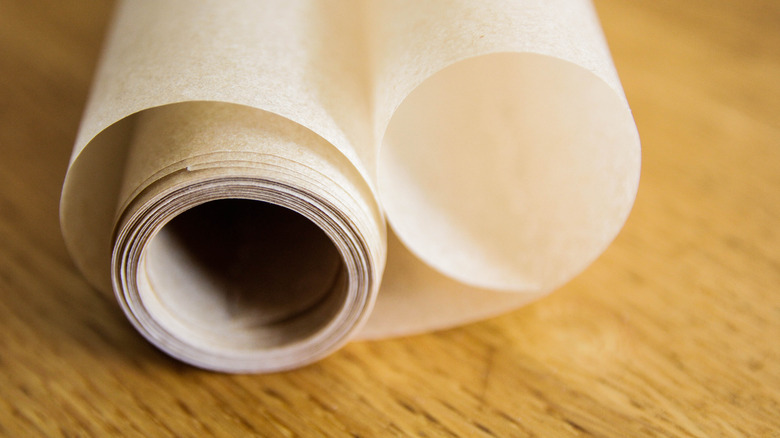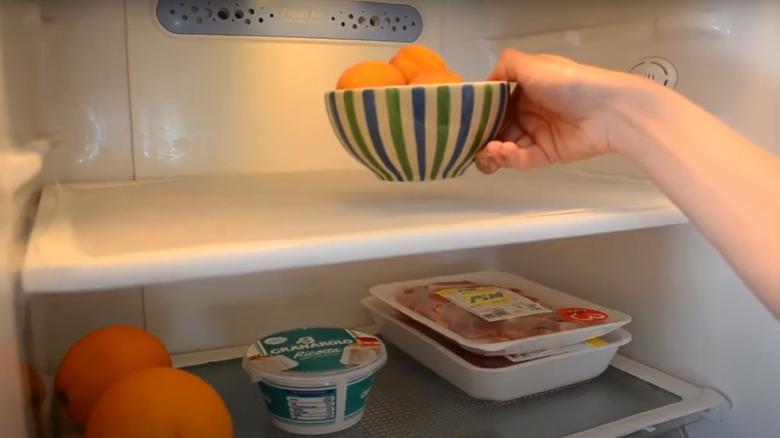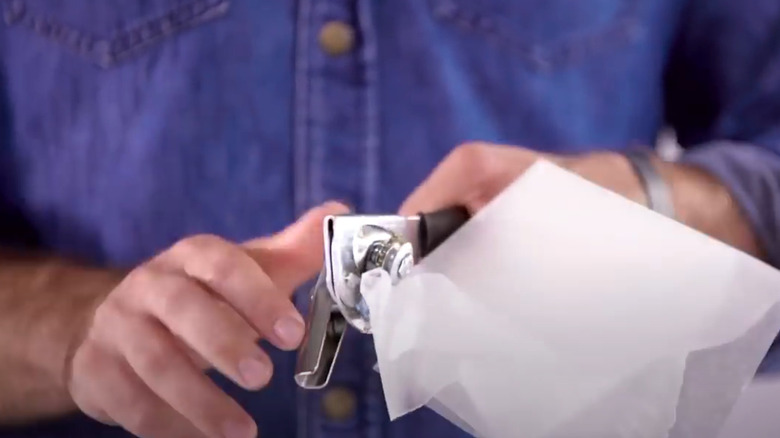Clever Wax Paper Tricks You Should Be Using When Cleaning Your Kitchen
We may receive a commission on purchases made from links.
Cleaning your kitchen can be a lengthy, time-consuming process, especially when you're inspired to deep clean it. From tackling the dust and grease buildup on top of your cabinets to removing all the gunk from your gadgets' nooks and crannies, it can be a tad overwhelming. This is why most of us look for shortcuts to help finish those tasks faster but with the same results. Luckily, you have something of a secret weapon sitting in your kitchen drawer when it comes to doing just that. Wax paper, which is commonly used for rolling out dough or wrapping food, can help you clean some of the more annoying messes in the space.
You can use it to both clean away gunk and prevent dirt from building up in the first place. Just rip off a sheet and get to work. For instance, you can use a piece of wax paper to remove splotchy messes from your countertops that tend to smear, such as an upturned bottle of ketchup or hot sauce. You can also use it to help make cleanup a breeze during parties or holidays by lining the countertops or tables with sheets of it. Once done, simply crumple up the paper and toss the mess out. Here is a closer look at all the smart ways to repurpose wax paper around the house.
Add it to the tops of cabinets to protect them from dust and grease
There is no more dreaded task in the kitchen than cleaning the tops of cabinets. If they don't go all the way up to the ceiling, then those surfaces are vulnerable to dust buildup, just like anywhere else. But when grease particles from the stovetop mix with the settled dust, this creates a tacky layer that turns to cement and is a chore to scrub away. Rather than struggling with a degreasing spray while balancing on top of a ladder, make this annoying chore obsolete by simply using wax paper to line the tops of the cabinets. By doing so, the grease and dust will land on the paper, and you can simply remove the mess and toss it in the trash once a month. Then, just lay down a fresh layer.
You can give the tops of these surfaces a deeper clean with an all-purpose spray or a Swiffer duster about every six months if you would like, but if you keep up with this hack, you will see that the task isn't all that necessary. There is one small caveat to keep in mind, however. If you have a kitchen ceiling fan that you use often, you might want to weigh down the corners of the sheets with something you won't be able to see from the floor, like flat rocks or drapery weights like WANLIAN's Ceramic Curtain Weights.
Line your fridge shelves to prevent spills and stains
In a similar vein, if you hate deep cleaning your fridge shelves, take the task off your to-do list with the help of wax paper. Here's why you should be putting wax paper in your fridge: Spills are inevitable in them. Whether your maple syrup leaks after getting jostled to the back or crumbs litter the shelf after someone helps themselves to plated leftovers, the messes can't be helped. And it can be pretty cumbersome removing all of your groceries and washing the shelves with soap and water once a month to remedy the situation. It often takes the better part of an hour, if not more, depending on how dirty the surfaces are. But if you line these shelves with wax paper, you can simply toss away the untidiness rather than having to scrub it. Granted, you will still need to remove all of your food items to both toss and replenish the sheets, but at least you won't have to use any sponges or muscle power to remove the mess.
To apply it to your shelves, simply roll out the paper and cut the appropriate length with scissors. While wax paper tends to stay down flat on its own, you can give it some help by placing some of your heavier items, like milk jugs, on the ends. If you have issues with it moving around, also consider adding double sided tape to the corners, such as Scotch Double Sided Tape.
Rub it on faucets to prevent water stains
It's always so satisfying when you finish washing the kitchen sink and step back to see the faucet and handles gleam. It makes your countertop look like something out of a showroom. The downside is that the effect is short-lived — in fact, you pretty much get water stains the second you turn on the tap and wash something. However, you can help prolong that chrome gleam by using wax paper to clean sink fixtures.
Since most brands of wax paper are coated with wax on either side, you don't have to worry about which side you use. Simply fold a small piece of paper and use it to buff down every inch of the faucet, handles, and surrounding base. Since wax is naturally hydrophobic, which means that it repels rather than absorbs water, the droplets will bead on your chrome surfaces and roll off. This will prevent any splotches from forming, helping you keep your sink area tidier for longer. Of course, though, this doesn't have a permanent effect. Depending on how often you use your sink, the wax will wear off after a few days, but you can reapply it with another sheet. However, keep in mind that not all wax paper is created equally. While you can get a cheap roll from the dollar store, it won't be as waxy as a name-brand one and won't give you as satisfying results. So if first you don't succeed, try another brand. I'm sharing this from experience!
Repel water off of wooden cabinets under the sink
Chrome isn't the only thing you can use wax paper on to repel water off of. You can also use it to protect the wooden cabinets directly under your sink. Wood is susceptible to water damage, and it's easy for spills and messes to happen while washing dishes. Whether you hit a spoon at just the right angle or you didn't notice you still had some water in that pot lid, a small flood will inevitably happen from time to time. While that won't bubble or warp your cabinet doors upon first contact, you run the risk of creating wear after years of such splashes. It's one of the ways you're damaging your kitchen cabinets without even knowing. To help avoid that, rub wax paper on those particular cabinets to protect them.
The hydrophobic properties of the wax will act as a shield, protecting the wood from any wayward streams. The water will simply bead on the surface and roll down to the floor rather than being soaked up by the wood. However, you don't need to rub the entire cabinet with it. Instead, focus on areas where you notice water settling the most, such as on top of the doors.
Limiting how much you put on can help keep the integrity of the cabinets intact. While wax isn't harmful to wood, it needs to be removed with a solvent to be washed away. Without the solvent, it can begin to accumulate, and you might be able to detect a noticeable buildup at some point. While it will take years for you to notice something foggy or discolored, keeping the wax concentrated to just the tops of the doors will help minimize any potential damage. Plus, it's much easier to deal with wax buildup than it is with water-damaged wood, so if you had to choose a lesser evil, it would have to be the wax.
Use it to remove messy spills like ketchup, mustard, mayo, etc.
Spills in the kitchen are inevitable, but you can make the cleanup a lot less painful if you just use the right tools. While spilling a glob of ketchup or hot sauce can be easily remedied with a wet sponge, spilling over half a bottle is trickier. Washing it with a sponge or paper towel will have it smearing, which means you have to go in about a hundred more times before the counter is clean. You can skip that mess altogether with the help of a cutting board and a sheet of wax paper.
Simply wrap the wax paper over the edge of the cutting board, creating a slick surface. Then, position the board at a 70-degree angle on your countertop or table, and slowly slide the board under the mess. It should transfer directly onto the paper, allowing you to toss the mess out in the trash. Since most condiments are water-based, the water molecules are repelled by the hydrophobic surface of the wax. This helps the mess stay suspended on the surface and not give it a chance to smear.
Keep your can opener gears clean
Our kitchens are stocked with a bevy of small gadgets that help make cooking more streamlined or convenient, but some of them are easier to clean than others. Many of them, like can openers, have small nooks and crannies that a normal sponge or scrub brush can't get into, making it challenging to properly clean. Because of this, you might be tempted to just leave it gunky until you eventually replace it with a new one. However, if you have wax paper on hand, that doesn't have to be your first course of action. Instead, you can use a waxy sheet to remove the food buildup from between the gears.
To de-grime your dirty can opener, fold a piece of wax paper several times so it gets some thickness to it. Then, place it between the gears, and turn it a handful of times. You should start to see the food residue come out on the paper. Continue to do so until it's completely clean. While this is a great way to clean old gunk out, it's also a great way to clean it immediately after use. That way, the residue will still be soft and liquid, making it much easier to remove from between the gears.
Use it to cover bowls to prevent splatter in the microwave
There is nothing more tedious than having to clean a splattered microwave, especially if the food residue has since dried. This can take all sorts of muscle power and contorting as you crouch and bend to see if you got every last splotch in those far corners and crevices. Rather than having to go through the hassle, keep the mess from occurring in the first place with the help of wax paper. The next time you need to heat something, tear off a sheet and use it to wrap either the plate or bowl. This will catch any popping or splattering food on the back of the paper, keeping your microwave sparkling clean.
Since the waxy layer on top of the paper is hydrophobic, those wet ingredients will simply hit the paper, bead up, and repel down. While wax paper isn't made for high-heat environments like ovens since the wax will begin to melt and the paper can ignite, it's perfectly fine in a microwave. The small appliance doesn't get hot enough to change the consistency of the paper, keeping both you and your food safe.
Use it to line your countertops during parties for easy cleanup
Are you hosting a large graduation party, or perhaps your Thanksgiving dinners seat a minimum of 40 people? If so, you're likely going to set up a buffet table on your countertops and island in order to feed the army of hungry guests who will be milling about your home. And when you have that many aluminum platters and heaping serving spoons, splatters and crumbs will be sure to cover every available surface. To keep the cleanup at the end of the night simple and pain-free, line those counters with wax paper as a protective cover.
Quilt the sheets together so they slightly overlap, ensuring sauces or spills won't get in between the seams. Then, place your platters on top, securing the paper in place. At the end of the night, simply crumple up the paper and toss it in the trash, leaving your surfaces relatively spotless. If you have some messier platters in your lineup, consider taping down the sheets in those areas to prevent spills from seeping through.


